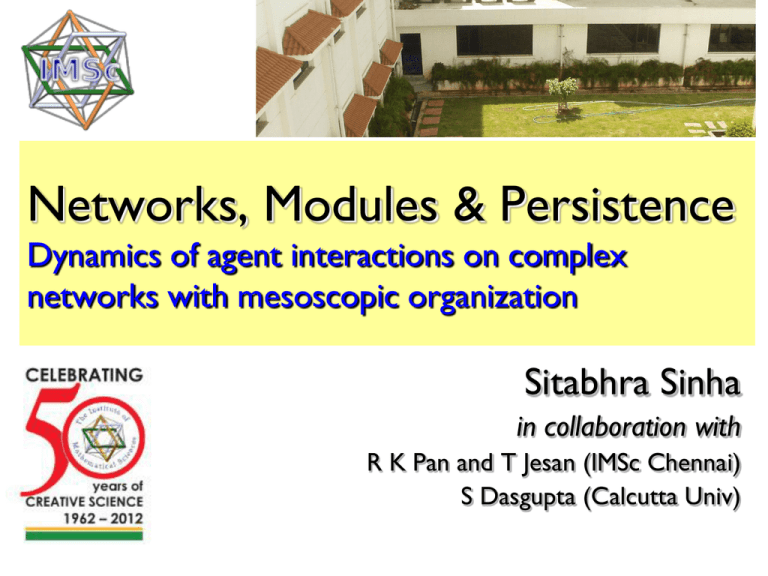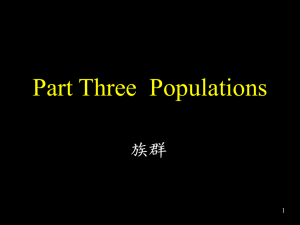Modular network
advertisement

Networks, Modules & Persistence Dynamics of agent interactions on complex networks with mesoscopic organization Sitabhra Sinha in collaboration with R K Pan and T Jesan (IMSc Chennai) S Dasgupta (Calcutta Univ) Primate Networks: Genesis of hierarchy Epidemics or contagion spreading Opinion or Consensus formation Social Network Research @ IMSc Popularity: Diffusion of products or ideas Games on Graphs Market Dynamics: Bubble & Crashes Themes • Are there common structural mesoscopic features in social networks ? Statics: modularity • What role do such network features play in governing network function ? Response & dynamics: polarization • How can such structures arise in general ? Evolution: multi-constraint optimization • Are there specific processes in social networks promoting such motifs ? Social games: Emergence of co-operation Importance of social network structure Contagion propagation in society through contact Spread of SARS from Taiwan, 2003 “The small-worlds of public health” (CDC director) Chen et al, Lect Notes Comp Sci 4506 (2009) 23 Why small-world pattern in complex networks at all ? We have shown that structurally Watts-Strogatz network ≡ R K Pan and SS, EPL 2009 Modular network All the classic “small-world” structural properties of Watts-Strogatz small world networks e.g., high clustering, short average distance, etc. are also seen in Modular networks Modular Networks: dense connections within certain subnetworks (modules) & relatively few connections between modules Modules: A mesoscopic organizational principle of networks Going beyond motifs but more detailed than global description (L, C etc.) Micro Kim & Park, WIREs Syst Biol & Med, 2010 Meso Macro Ubiquity of modular networks Modular Biology (Hartwell et al, Nature 1999) Functional modules as a critical level of biological organization Modules in biological networks are often associated with specific functions Metabolic network of E coli (Guimera & Amaral) Chesapeake Bay foodweb (Ulanowicz et al) Are social networks modular ? Let’s look at real re-constructed human social contact network: A mobile phone interaction network Onnela et al. PNAS,104,7332 (2007) Data: • A mobile phone operator in an European country, 20% coverage • Aggregated from a period of 18 weeks • > 7 million private mobile phone subscriptions • Voice calls within the operator • Require reciprocity of calls for a link • Quantify tie strength (link weight) 7 min 5 min 15 min (3 calls) Aggregate call duration Total number of calls 3 min J-P Onnela Reconstructed network Onnela et al. PNAS,104,7332 (2007) Modularity of social networks 4.6 106 nodes 7.0 106 links Modularity: Cohesive groups communities with dense internal & sparse external connections Other examples of modular social networks – Scientific collaborators – e-mail communication – PGP encryption ”web-oftrust” – non-human animals Onnela et al. PNAS,104,7332 (2007) Q. What structure ? Ans. Modular Next… How do such structures affect dynamics ? Over social networks, such dynamics can be of information or contagion spreading consensus or opinion formation adoption of innovations Social Network of a Karnataka Village Data: microfinance institution Bharatha Swamukti Samsthe Nodes: Individuals Links: Social relations Described in Banerjee et al, Science (2013) Village “52” Population:1525 individuals Largest connected component 1497 individuals 43 modules Largest module contains 15.5% of nodes 32 modules contain less than 1% of nodes Node colors represent the community to which they belong Measuring modularity How to quantify the degree of modularity ? One suggested measure: (Newman, EPJB, 2004) A: Adjacency matrix L : Total number of links ki : degree of i-th node ci : label of module to which i-th node belongs A For directed & weighted networks: ( W: Weight matrix si : strength of i-th node Modules determined through a generalization of the spectral method (Leicht & Newman, 2008) C B ) D To model the transmission of contagion on the network we use SIRS dynamics The “infectiousness” of a contagion To measure the force of infection of a contagion (how quickly it can spread) we use the empirically measurable quantity Basic reproduction number R0 Mean number of new infections caused by a single infectious individual in a wholly susceptible population (as in the beginning of an epidemic): If each infected person on average infects more than one other individual, R0 > 1 Epidemic For a contagion spreading on a contact network • if the probability of infection is , and, • if k is the average degree of the contact network Then R0 kg where g : mean generation interval We investigate the long-term transmission of contagia in modular contact networks In particular, Persistence i.e., existence (circulation) of contagion in the population for an indefinite period, i.e., I(t) > 0 as t A contagion that starts out as an epidemic, eventually either dies out [I(t)=0] or becomes endemic Hollingsworth, J Pub Health Policy, 2009 Contagia in empirical network comprising communities are surprisingly persistent in contrast to those in degree-preserved randomized networks which do not have modular organization Difference even more pronounced if modularity is enhanced by decreasing the intermodular connectivity Can modular organization of contact network have significant impact on the long-term dynamics of contagia spreading ? A simple model of modular networks Model parameter r : Ratio of inter- to intra-modular connection density Module ≡ random network Comparison with Watts-Strogatz model Structural measures used: Communication efficiency E = 1 /avg path length, ℓ = 2 /N(N-1) i>jdij Clustering coefficient C = fraction of observed to potential triads = (1 /N) i2ni / ki (ki - 1) WS and Modular networks behave similarly as function of p or r (Also for between-ness centrality, edge clustering, etc) How can you tell them apart ? Dynamics on Modular networks different from that on other small-world (Watts-Strogatz) networks Network topology Consider ordering or alignment of orientation on such networks e.g., Ising spin model: dynamics minimizes H= - Jij Si (t) Sj (t) 2 distinct time scales in Modular networks: t modular & t global Global order Modular order Time required for global ordering diverges as r →0 Eigenvalue spectra of the Laplacian Shows the existence of spectral gap distinct time scales Modular network Laplacian spectra gap Spectral gap in modular networks diverges with decreasing r No gap WS network Laplacian spectra Existence of distinct time-scales in Modular networks No such distinction in Watts-Strogatz small-world networks Signal propagation on contact networks with community organization can take extremely long times Diffusion process on modular networks E.g., Random walker moving from one node to randomly chosen neighboring node Pan & Sinha, EPL 2009 Distrn of first passage times for random walks Shows the existence of two distinct time scales: • fast intra-modular diffusion • slower inter-modular diffusion while random networks show a continuous range of time scales In modular networks, signal spreads slowly from module to module ! SIRS Dynamics: Existence of communities can make highly infectious contagia persistent m=64 modules of size n=16 avg degree <k> = 12 Avgd over 100 rlzns r = 0.0002: rapid extinction For isolated modules (r=0) and homogeneous networks (r=1) epidemic with high R0 dies out quickly r = 0.002: persistence r = 0.02: rapid extinction However, for a critical range of modularity for contact network (r ~ 10-3), highly infectious contagia are persistent. Persistence in a critical range of modularity Distribution of persistence time shows bimodal character for large r – with the upper branch diverging for a critical range of modularity… Effect of increasing the number of modules …while for lower r the distribution is unimodal with avg decreasing rapidly as the modules are effectively isolated (R0 = 6) The mechanism of enhanced persistence Time-scale for global diffusion (inverse of smallest finite Laplacian eigenvalue) decreases with r… …. So does the timescale separation between inter- and intra-modular events (the Laplacian spectral gap) However – the ratio of the two show nonmonotonic dependence on contagion spreads slowly from module to module, allowing parts of the network to recover before return of infection! modularity Order-disorder transitions in Social Coordination How does existence of different time-scales affect consensus formation dynamics on networks with communities Q. How does individual behavior at micro-level relate to social phenomena at macro level ? E.g., can social polarization occur as a result of modular network structure even when all relations are “friendly” ? Spin models of statistical physics: simple models of coordination or consensus formation •Spin orientation: mutually exclusive choices •Choice dynamics: decision based on information about choice of majority in local neighborhood •Temperature: noise or degree of uncertainty among agents Simplest case: 2 possible choices Ising model with FM interactions: each agent can only be in one of 2 states (Yes/No or +/-) possible order in modular network of “spins” No consensus Consensus Modular order Global order N spins, nm modules FM interactions: J > 0 (“Friendly” interactions) Avg modular order parameter System or global order parameter Phase diagram: two transitions r = 0.002 T There will be a phase corresponding to modular but no global order (coexistence of contrary opinions) even when all mutual interactions are FM (favor consensus) ! Divergence of relaxation time with modularity Even when global order is possible, i.e., strongly modular network takes very long to show global order Time required to achieve consensus increases rapidly for a strongly modular social organization But then … How do certain innovations get adopted rapidly ? Possible modifications to the dynamics: Positive feedback Different strengths for inter/intra couplings I. The effect of Positive Feedback Brian Arthur The case of “counter-clockwise” clocks Microsoft & the 7 Dwarves The effect of Positive Feedback Introduce a field H = hM (proportional to order parameter) Effectively increases intermodular interactions Drives system away from critical line by increasing Tgc reduces II.Varying Strength of Coupling Between & Within Modules Marc Granovetter J0 : strength of inter-modular connections Ji : strength of intra-modular connections increasing J0 / Ji increasing r Non-monotonic behavior of relaxation time vs ratio of strengths of short- & long-range couplings Not seen in Watts-Strogatz SW networks (Jeong et al, PRE 2005) Why Modular Networks ? Suggestion: modularity imparts robustness Not quite ! Consider stability of a random network with a modular structure. E.g.,Variano et al, PRL 2004 N=256 As random networks are divided into more modules (m) they become more unstable… … however, we see modular networks all around us. Why ? Question: Why Modular Networks ? Clue: Many of these modular networks also possess multiple hubs ! Most real networks have non-trivial degree distribution Degree: total number of connections for a node Hubs: nodes having high degree relative to other nodes Why Modular Networks ? R K Pan & SS, PRE 76 045103(R) (2007) Hypothesis: Real networks optimize between several constraints, •Minimizing link cost, i.e., total # links L •Minimizing average path length ℓ •Minimizing instability max Minimizing link cost and avg path length yields … … a star-shaped network with single hub But unstable ! Instability measured by max ~ max degree (i.e., degree of the hub) In fact, for star network, max ~ N How to satisfy all three constraints ? Answer: go modular ! As star-shaped networks are divided into more modules they become more stable … = 0.4 Increasing stability, average path length = 0.78 =1 …as stability increases by decreasing the degree of hub nodes max ~ [N/m] Shown explicitly by Network Optimization Fix link cost to min (L=N-1) and minimize the energy fn E () = ℓ + (1- ) max [0,1] : relative importance of path length constraint over stability constraint N = 64, L = N-1 Transition to star configuration The robustness of modular structures We have considered dynamical instability criterion for network robustness – how about stability against structural perturbations ? E.g., w.r.t. random or targeted removal of nodes Scale-free network: robust w.r.t. random removal Random network: robust w.r.t. targeted removal Is the modular network still optimal ? Surprisingly YES ! At the limit of extremely small L, optimal modular networks ≡ networks with bimodal degree distribution… …has been shown to be robust w.r.t. targeted as well as random removal of nodes Tanizawa et al, PRE 2005 Modularity via games between selfish rational agents So far, we looked at rather general processes for evolving modularity Our agents are relatively “naïve”, whose rules for making choices do not explicitly take into account how the other agents choose What happens if our agents are capable of “strategic” decision making (i.e., taking into account how other agents will behave) ? Can there be specific processes at work in social networks that promote the emergence of community structure ? Social games: Emergence of co-operation Prisoners Dilemma originally framed by Merrill Flood and Melvin Dresher at RAND (1950) In the iterative setting, an ideal model for analyzing the conditions for the emergence of cooperation Payoff Matrix Cooperate Defect Cooperate R,R S,T Defect T,S P,P T: Temptation to defect R: Reward for cooperation P: Punishment for mutual defection S: Sucker’s payoff In general, T > R > P > S Usually, R=1, P=0, S=0 and 1<T<2 Prisoners Dilemma in a network Spatial Prisoners 1.75< T <1.8 Dilemma: Nowak & May, Nature 1992 1.8< T <2 Agents play with neighbors on a lattice, adopting strategy of neighbor with max payoff Network Prisoners Dilemma: agents play with nbrs in the network, compare payoff with randomly chosen nbr and adopt strategy of neighbor having higher payoff with a probability Stability w.r.t. defection Robustness w.r.t. removal of nodes Role of modules: Fragmenting the network into several sparsely connected communities, each with star configuration, allows cooperation to be robust – modularity beneficial if degree distribution is bimodal The evolution of cooperation driving the emergence of modular structures C C C D D C C D C D Link adaptation dynamics C C C C D C D Could modularity in social networks have arisen as a result of modules promoting cooperation – necessary for building social organization ? D To Summarize • Are there common structural mesoscopic features in social networks ? Statics: modularity • What role do such network features play in governing network function ? Response & dynamics: polarization • How can such structures arise in general ? Evolution: multi-constraint optimization • Are there specific processes in social networks promoting such motifs ? Social games: Emergence of co-operation Thanks





![Wrapping Machine [VP] OPP film wrapping for flat](http://s2.studylib.net/store/data/005550216_1-6280112292e4337f148ac93f5e8746a4-300x300.png)


